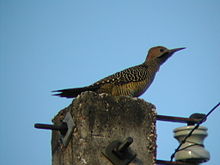- Fernandina's Flicker
-
Fernandina's Flicker 
Bermejas, Cuba Conservation status Scientific classification Kingdom: Animalia Phylum: Chordata Class: Aves Order: Piciformes Family: Picidae Genus: Colaptes Species: C. fernandinae Binomial name Colaptes fernandinae
Vigors, 1827Synonyms Nesoceleus fernandinae
Fernandina's Flicker (Colaptes fernandinae) is a species of bird in the woodpecker family. Endemic to Cuba, its small population of 600–800 birds makes it one of the most endangered species of woodpecker in the world;[2] only the possibly-extinct Ivory-billed Woodpecker is known to have a smaller population. The Fernandina's Flicker is threatened by habitat loss.
Contents
Description
The Fernandina's Flicker is a medium-sized woodpecker, ranging in length from 14–15 inches (33–35 cm).[3] Overall, it is mostly yellowish-tan, covered with varying amounts of black barring; its underwings are yellow. The male has a black moustachial stripe, which the female lacks.
Distribution and habitat
The Fernandina's Flicker is endemic to Cuba. Though it was apparently never common, it was formerly found across the island.[4] Now, however, it is restricted to isolated locations in nine of the country's 15 provinces: Camagüey, Cienfuegos, Granma, Holguín, Las Tunas, Matanzas, Pinar del Río, Santiago de Cuba, and Villa Clara.[1] The largest population is found in Zapata Swamp, where some 120 pairs are estimated to live, though this number may have dropped following recent hurricanes.[1][4]
The flicker's natural habitats include dry forests, dry savanna, swamps, and pastures.
Behavior
Though not a particularly social bird, the Fernandina's Flicker will sometimes form loose colonies of up to 15 pairs.[3] It regularly fights with other woodpeckers.
Feeding
Like its congeners, the Fernandina's Flicker often forages—primarily for ants, but also for other insects, worms, grubs and seeds—on the ground.[2][3] It uses its strong bill to probe the ground, and flick aside leaf litter.
Breeding
The Fernandina's Flicker breeds between March and June;[3] during courtship, pairs regularly engage in high-flying chases. Like all woodpeckers, it is a cavity nester. Recent fieldwork has shown that it prefers to use nest holes started by West Indian Woodpeckers; the flicker usurps the original owners, finishes off the excavation work, and moves in.[2] The female lays a clutch of three to five white eggs,[3] which are incubated for a period of about 18 days. Young fledge after 22 days.[2]
Voice
Though it is regularly silent, the flicker's calls include a repeated wicka (the onomatopoeic sound which gives the genus its common name), and a loud series of pic notes.[2]
Conservation
With an estimated population of only 600–800 birds, the Fernandina's Flicker is one of the most endangered woodpeckers in the world.[2] Overall, that population is declining, principally because of habitat loss.[1] Farming, logging, hurricane damage and the caged bird trade—trappers bring down whole palm trees in order to capture nestling Cuban Amazons (Amazona leucocephala leucocephala)[5][6]—are combining to squeeze the remaining birds into smaller and smaller isolated tracts.[2] In addition, West Indian Woodpeckers have been observed killing the chicks of Fernandina's Flickers.[6]
Sources
Citations
- ^ a b c d "BirdLife International Species factsheet: Colaptes fernandinae". BirdLife International. http://www.birdlife.org/datazone/species/index.html?action=SpcHTMDetails.asp&sid=687&m=0. Retrieved 2007-12-07.
- ^ a b c d e f g Leonard, Pat (Summer 2007). "Fernandina's Flicker: Flashy flickers are few and far between". BirdScope 21 (3): 20. http://www.birds.cornell.edu/Publications/Birdscope/Summer2007/fernandinas_flicker.html. Retrieved 2007-12-07.
- ^ a b c d e Raffaele, Herbert; James Wiley, Orlando Garrido, Allan Keith & Janis Raffaele (1998). A Guide to the Birds of the West Indies. Princeton University Press. pp. 349. ISBN 0-691-08736-9.
- ^ a b Winkler & Christie 2002, p. 514
- ^ Mitchell, Andy; Lyn Wells. "The threatened birds of Cuba project report". Cotinga 7 (1): 69–71. http://www.neotropicalbirdclub.org/articles/7/C7-cuba.pdf.
- ^ a b Wechsler, Doug (Mar-Apr 1998). "Dark times for Cuba's Sabal palms - endangered trees of Zapata Swamp". International Wildlife 28 (2). http://findarticles.com/p/articles/mi_m1170/is_n2_v28/ai_20341173.
References
Winkler, Hans; Christie, David A. (2002). "Family Picidae (Woodpeckers)". Handbook of the Birds of the World, Volume 7: Jacamars to Woodpeckers. Barcelona: Lynx Edicions. pp. 296–555. ISBN 84-87334-37-7.
External links
- Fernandina's Flicker photos from the Visual Resources for Ornithology department of the Philadelphia Academy of Natural Sciences
- Fernandina's Flicker videos from Handbook of the Birds of the World's Internet Bird Collection
- Fernandina's Flicker on stamps
Categories:- IUCN Red List vulnerable species
- Colaptes
- Birds of Cuba
- West Indian restricted-range endemic bird species
- Woodpeckers
Wikimedia Foundation. 2010.

